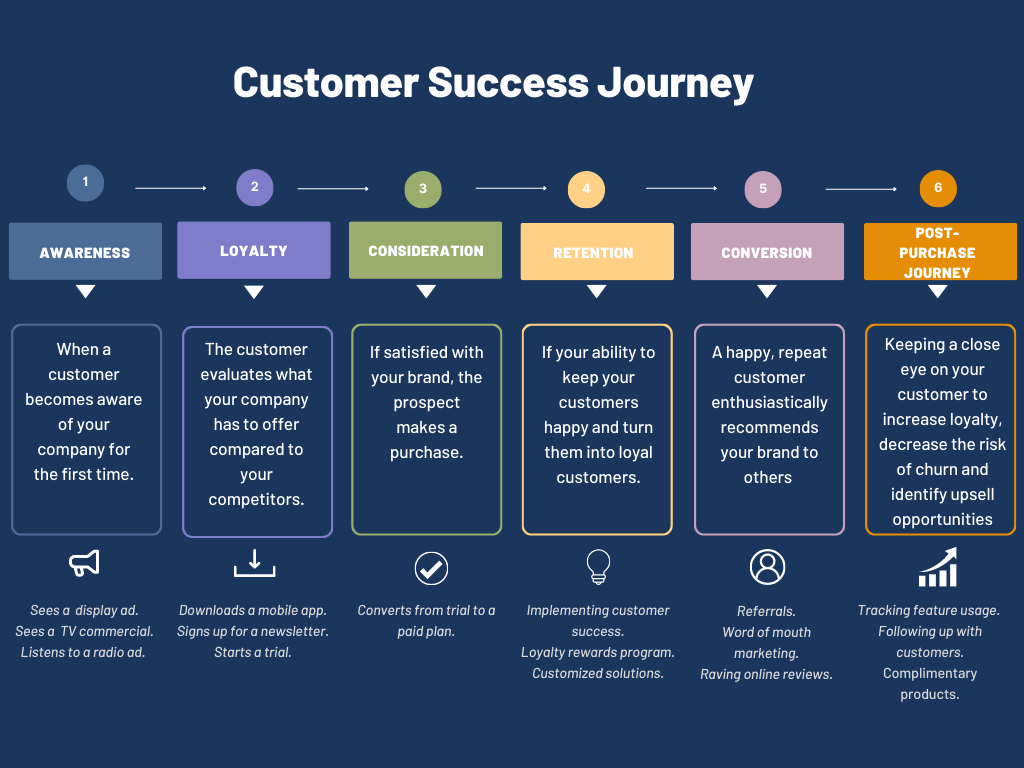A great client experience doesn’t happen by chance. It is the product of understanding how clients interact with your brand and deliberately building in high points that:
- Delight clients at different stages of the customer journey
- Help them achieve specific goals
To deliver a great client experience, you need a customer success journey map — a blueprint that spells out the exact steps a client will go through to achieve success with your brand.
Customer success journey mapping is a SaaS strategy, but you can apply it to your business to transform how you interact with your audience and clients as a creator!
This article discusses practical steps for creating an effective customer success journey map. We’ll cover the following:
- What is a customer success journey map?
- The benefits of mapping your customer success journey
- How to create a customer success journey map
What is a customer success journey map?
A customer journey success map is a step-by-step plan for delivering an excellent post-purchase experience to your clients.
It shows how clients interact with your brand — from the point of first purchase through to repeat patronage — and what needs to happen at each interaction stage to ensure your clients have a great experience with your brand.

Why do you need a customer success journey map?
With a customer success journey map, you can:
The customer journey is complex, and it’s pretty easy for things to slip through the rails — which can have dire consequences for your brand as a creator. One lapse here, another there, and you have a dissatisfied client before you know it.
Customer success journey mapping fixes this issue. The mapping process allows you to uncover otherwise overlooked friction points — like payment glitches and broken workflows — that could negatively impact customer experience. Or to optimize existing touch points for a smoother experience overall.
Say you’re selling to a global audience, but your payment gateway only accepts transactions from the U.S. and Canada — you can proactively set up an alternative payment channel. Doing this early saves you from losing a customer at the point of sale due to payment challenges in the future.
Here’s something we’re all too familiar with:
One of your friends recommends a particular creator after having a great experience with their brand. But, after interacting with the creator, you leave with an entirely different impression. This is what happens when any brand fails to standardize its overall customer experience.
A customer success journey map solves this problem. How? it guides your entire customer success strategy so every client enjoys the same experience with your brand, regardless of when, where, or how they interact with you.
During the mapping process, you define specific customer success requirements for every stage of interaction. For example, one of your customer success requirements could be sending a welcome message with a discount code for your course to new subscribers in your paid community — or shouting them out on social media.
Once you’ve spelled out what needs to happen throughout the interaction stages, it becomes much easier to follow through with them and deliver consistent client experiences.
Related: How to improve digital customer experience
Trust is your currency as a creator. People must trust your brand enough to listen to your recommendations, pay for your courses or join your communities. Apart from building a community, trust also helps you win juicy brand deals and collaborations.
To build trust, you must meet your client’s expectations — which means saying what you’ll do and doing what you say. Customer success journey mapping can help here.
Once you’ve spelled out what needs to happen at each stage of your interaction with your client, setting, communicating and meeting these expectations becomes a breeze. For example, you can tell the client they will receive a gift card from your brand after their first purchase because you’ve already set up the process for making it happen.
Related: How to scale customer success with education
How to develop a customer success journey map
There are many examples and templates for customer success journey mapping. But ultimately, customer success journey mapping is unique to your brand — always remember that!
No two clients are alike, so take time to understand how your clients define success and create processes that empower them to achieve it.
You need to know how your clients define success to avoid wasting time on a goal or objective they have no interest in. Many times, clients have a different goal or objective than what we believe they want to accomplish.
So how do you discover what your clients want to achieve? It’s simple — ask them. And there are several ways to do this:
- When you gain a new follower on social media, send a short message asking why they decided to follow you and what they expect to gain.
- Send a welcome email to new community members asking what they expect from your content.
- Add a “what would you like to see from me” field to sign-up forms on your website.
Break the customer journey into stages to make it easier for you to map out core experiences for your clients. As we mentioned earlier, the customer success journey is complex, and it’s easy to overlook important processes if you try to tackle customer success journey mapping as a whole.
The exact stages depend on your brand and the type of clients you have. But, generally, they should be something like this:
- Purchase: The client decides to buy your course or collaborate with your brand
- Onboarding: The client is set up for a successful collaboration with your brand. Say they just joined your paid community; send them a short welcome email with details of community events, the administrators, and answers to frequently asked questions.
- Adoption: The client uses your product or service to achieve their goals.
- Retention: Based on how well you helped the client meet their goals, they might choose to continue using your product or services. Read this article to learn more about customer retention and why it is important.
- Loyalty and advocacy: The client is satisfied with their experiences and helps you acquire new clients using word-of-mouth marketing.
Brand or customer touchpoints are interaction points between clients and your brand. Once you’ve set your touchpoints, you can optimize them to deliver a consistent client experience across the board.
On a high-level, most creators stick with the following touchpoints:
- For purchase: Landing pages and websites
- For onboarding: Email drips
- For adoption: Learning management systems like Thinkific and community tools like Slack and Microsoft Teams.
- For retention: Owned channels like free communities and newsletters.
- For loyalty and advocacy: Social media platforms like TikTok, Instagram, and Twitter; websites and third-party creator review sites like Grin.
This categorization isn’t set in stone; one touch point can apply to multiple stages. For example, some creators use payment features within social platforms to sell digital products to subscribers. And others host their digital products directly on their websites instead of a learning management system.
| For Purchase | Landing pages and websites |
| For Onboarding | Email drips |
| For Adoption |
|
| For retention | Free communities and newsletters |
| For loyalty and advocacy | Social media, third-party review sites, and creator marketplaces |
Here’s how this plays out in real time:
A client purchases your new course via a landing page. After the purchase, they receive a welcome email with login access to your learning management system where the course is hosted.
As the course progresses, they receive check-in emails with tips to help them make the best of the course. They also get automatic access to your Slack community to connect with other students, ask one-on-one questions and receive personalized feedback.
At the end of the course, they decide to share their experience on social media, which helps your business win new clients.
Customer milestones are the actions that must happen in specific customer journey stages for that stage to be deemed successful — think of them as items on a customer journey success checklist. Milestones help you track the client’s progress toward a specific goal.
You need to answer two important questions as you define customer milestones:
- What is the client’s goal at this stage of interaction?
- What needs to happen for them to achieve that goal?
In the adoption stage, for example, one of the milestones could be the client registering for a one-on-one feedback session after wrapping up onboarding. And in the loyalty stage, one of the milestones could be the client clicking the personalized referral link in your weekly newsletter — bringing them closer to engaging in word-of-mouth marketing for your brand.
Success metrics help you measure the effectiveness of each milestone — that’s how well a particular milestone leads the client to the next one until they complete the customer success journey.
Setting success metrics for milestones is a pretty straightforward process. Think of the action the milestone is supposed to accomplish and add that to your customer success journey map.
Using our consideration stage example — say a client clicks the signup link but doesn’t actually sign up for your newsletter. Then the “click newsletter link” milestone isn’t successful in this case. For it to count, the client needs to complete the signup process.
Now, it’s time to create your customer success journey map. You can build it from scratch using tools like Google Sheets and Microsoft Excel or visualization tools like Miro and Figma.
You also have the option of using a template. This is a better choice if:
- You’re creating a customer success map for the first time
- You want to save time.
Customer success journey mapping isn’t a one-and-done process
Your clients are dynamic, and how they define success will shift over time. To keep up with these changes, you must continuously improve your customer success journey map.
Build a feedback process into your customer journey map to easily track what’s working and what needs improvement. And don’t be afraid to test new milestones and customer journey stages — they might serve your clients better!
Enjoyed reading this? Dive deeper into customer success strategies for creators with our ultimate guide.







